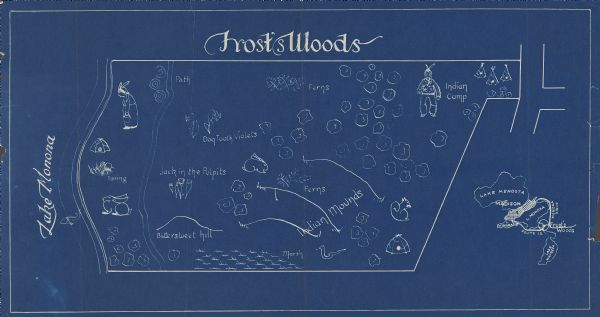Winnebago Natives
Frost Woods area once sheltered a Winnebago Village. The Winnebago camped in small numbers in the woods and brush along the Monona shore. This area was well protected against fierce weather and invasion of unfriendly natives. Ancient skeletons and artifacts were found during several periods when burial mounds were cut into during road and homes construction. These artifacts revealed that the wooded slopes were once scattered with wigwams.
There are two groups of Burial Mounds in the Frost Woods area: Frost Woods Group and Fairhaven Group. The Frost Woods group was in a dense wooded area near the outlet of Lake Monona, formerly a part of the Frost farm and a short distance south of the Fairhaven mounds. There were four linear earthworks, a conical mound and a bird effigy. There were two more mounds that were injured by the cultivation of land, a conical mound and a panther effigy. Fairhaven mounds group were so named for the Fairhaven subdivision, which incorporated much of southern Monona.
The mounds were located in a densely wooded area and consisted of two panther mounds and three linear earthworks. While one panther mound was significantly destroyed during land cultivation, the other remains fairly unharmed. It has a notable feature of an upward curve at the end of its long tail. South of the panther mound was a tapering linear mound that was cut through during the construction of the road leading to the rear of Bungalowen.
Although the land became property of the United States government after the Native American treaties of 1829 and 1833, Winnebago families still camped here to hunt and fish during the summer into the late 1920s. The land was sold and slated for development during which almost all of the mounds were destroyed.
Frost Woods: a Historically Beautiful Place
By Emily Hopkins
2013 Senior Scholarship Winner
Monona, a Native American word for “beautiful,” was founded as early as 7,000 B.C. Many aspects of the city of Monona set it apart from others in the area including its closeness to the water, the closeness to the capital and the historical importance to the state of Wisconsin. One thing that is not widely known about the city is that it sits upon many ancient effigy mounds. Many of these mounds are located in the Frost Woods neighborhood area, which sets this neighborhood apart from the others.
Monona was home to a division of the Woodland Group known as the Effigy Mound Builders. These Effigy Mound Builders were nomadic and relied heavily on fishing, hunting, and gathering. The thing that set these Native Americans apart from the rest was their ability to form mounds to bury their dead and keep artifacts. These mounds came in the shapes of many various animals including turtles, deer, and eagles. Many mounds were built around the area but today only 10 or so mounds remain still in tact. The mounds located in the Frost Woods Neighborhood, are a prime example of why this neighborhood is rich in historical importance to not only the city of Monona but also the state of Wisconsin.
The effigy mounds were also used for seasonal social and religious gatherings. The idea that the mounds were a common meeting place is still used in the Frost Woods neighborhood today. The neighborhood has its annual clambake where the whole neighborhood gets together and celebrates another year. It is a perfect time to meet new members of the neighborhood and celebrate with the old.
The festival that is present today can be contrasted to a ceremony that the Effigy Mound Builders would have put on in order to celebrate the start of a new season. It’s important to keep traditions in place like this one in order to maintain a friendly and safe neighborhood for everyone.
As a resident of the Frost Woods neighborhood, I find it at great importance to understand and learn about the history of my neighborhood. My house has effigy mounds surrounding it and it’s amazing how much history is present so close to me. Everyone should take the time to learn about what kind of importance his or her neighborhood has in history because no matter how big or how small everything is relevant.










